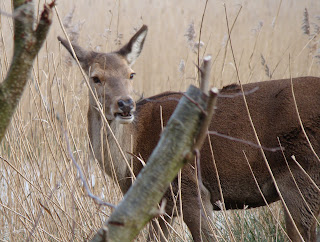Where does the time go? February saw us visiting Pitsford Reservoir in snow and ice, Otmoor Reserve in cool but brilliant sunshine, Wicken Fen in the rain and a second visit to Pagham Harbour with Bedford RSPB Local Group and last but not least Titchwell and Holkham.
The highlights at Pitsford were a group of Goldcrests flitting in and out of the trees, Goldeneye and Smew in pairs and a very lucky fly-over of a Woodcock. There was a very large flock of Canada Geese which dominated the areas around the open water.
Smew at Pitsford
 |
| A pair of Goldeneye |
After leaving Pitsford we went to Fineshade which was also very icy (except for the lovely hot chocolate, enjoyed in the cafe). There wasn't much about, Marsh and Coal Tit on the feeders were the best we could do! So we made our way back home via Corby, counting Red Kites as we went.
Malcolm and I went on a mid-week trip to Otmoor, hoping to see Short-eared Owls but the best we could do was a Peregrine, a large mixed flock of Fieldfare and Redwings and Mealy Redpolls and Yellowhammers near the feeders.
A morning visit, in drizzle, to Stockgrove gave us some good views of Nuthatch and some cheeky Grey Squirrels.
 |
Nuthatch at Stockgrove
|
We went to Wicken Fen on a most unpromising day, weather-wise, but the forecast had said it would brighten later! So we didn't go out very early and we managed to stay reasonably dry. The effort was not wasted. Mid-afternoon saw us approaching the 'tower' hide which was already occupied by a couple of birders, we just filled it to capacity! We were delighted to see up to four female/juvenile Hen Harriers hunting and perching on posts or on the ground. The clouds drifted away to leave a beautiful setting sun which cast a golden glow across the reserve. The birds looked magnificent in the sunlight. A Short-eared Owl was seen, briefly, hunting over the fen and at least two Barn Owls joined in the hunting spree. Unfortunately it was not a good day for photography.
Our second visit, for the year, to Pagham Harbour was very enjoyable. We saw the usual waders and geese but the highlight for us was the overwintering? Black Redstart at Selsey which eventually showed very well. There were quite a few Med Gulls, especially on the beach near Church Norton, where the receding tide invited more and more waders down to feed.
Black Redstart
On the last weekend of February we decided to try our luck in North Norfolk for the Rough-legged Buzzard that had been eluding us last year. We made an early start so that we could visit Titchwell first - this proved to be a wise decision. Along the path to the visitor centre we stopped to see if the Redpolls were about, we could hear them but not see them until we spotted a couple flying over the tree tops and away. A Treecreeper calling was easy to spot, then another turned up so we watched them long enough to get a couple of photos.
 |
| Treecreeper at Titchwell |
We caught up with the Redpolls in the alders along the path, they were a mixed group but we were unable to identify the Coue's in amongst them. Then we made our way down to the sea where we had one of our best Titchwell seawatches. Long-tailed Ducks, Red-throated Divers, Velvet Scoter and Eider to name but a few!
At Holkham we parked up and made our way to the beach in the hope of catching up with the Shorelark but there were too many people about on such a lovely sunny day! A Barn Owl sat on a post in full view, looking for it's lunch. After walking along to the hides and drawing a blank on the RL Buzzard we decided to call it a day. Sitting in the car ready to drive off Malcolm spotted a Buzzard flying along the woodland edge between Holkham and Wells and it was 'hovering' so we quickly got our bins out just as it dropped out of sight!! Perseverance paid off as it reappeared, briefly, a few minutes later. Not great views but definitely the Rough-legged Buzzard!





























